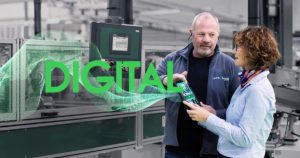The intriguing side of digital transformation is not so much the new ways in which machines now interact with each other, but as the innovative ways in which people are collaborating. Even 10 years ago, it was unthinkable for people to use their own personal vehicles as taxis for transporting paying customers from one location to another. Yet companies like Lyft and Uber have leveraged digitization to create a new business model. And business models, when you fundamentally dig into them, are based on how people interact with each other.
The same phenomenon is now influencing the way the industrial sector is operating. Young engineers are coming into the workforce and looking at new communications channels for solving the manufacturing problems that confront them. Many are turning to unconventional, crowd-sourcing networks that reach beyond the traditional, serial approach of one company talking to another. Instead, one individual is communicating to other individuals, or group of individuals, to discover and co-develop new solutions that address industrial challenges.
In order to facilitate this spirit of collaboration, Schneider Electric has recently introduced a new, open platform called Schneider Electric Exchange. The purpose of Exchange is to foster and nurture the development of new ideas via a community of manufacturing industry experts that both share and consume new concepts and solutions. The type of experts joining the Exchange community include system integrators, end users (such as plant managers and building owners), technology companies (start-ups, small medium sized companies), and specifiers/engineering consultants.
A unique combination of marketplace and community
The Exchange ecosystem combines the power of the marketplace with that of an active online community. On the community side, Schneider Electric has already on-boarded over 20,000 partners as platform participants. These are knowledgeable experts who interact easily over a platform they have learned to trust as a more efficient means for conducting business. On the marketplace side, the ideas exchanged serve as leverage points for transacting software product sales, offer introductions, services, business leads, and resource capacity sharing.
The idea of Exchange is that individuals enter the platform, ask specific questions, and receive answers. Exchange is not a channel for addressing technical support questions, it’s a problem-solving approach. Through the engagement of a community of solvers, a number of interesting Exchange use cases have emerged:
- Case #1: Pertinent solution to offer the marketplace –
Itris Automation provides PLC Checker on Exchange, a static analysis tool which automatically analyses PLC programs and comprehensively verifies their compliance with a set of coding rules, that can be generic or specific to an industry, process, or norm. Using PLC Checker replaces the need for manual verification tests, which take a considerable amount of time and might not provide the level of quality, required. Thanks to PLC Checker, it is now possible to systematically adopt coding standards while ensuring a certain robustness and readability of the application.
“PLC Checker was identified as the solution for verifying more quickly and easily that the code provided by the OEMs conforms with Ford’s requirements. We found PLC Checker easy to use with a good user interface. The analyses performed by the tool are very detailed and they provide good feedback.” Scott Arboleda, Ford
- Case #2: Ideas to solve a perplexing business problem:
InUse provides a SaaS application that allows machines to talk to improve production performance of factories. Based on the digitization of the manufacturer’s industrial know-how and machine data processing, the application delivers connected services that solves production issues within factories. InUse was a Top 5 winner of a recent Innovation Challenge to focus on a way to optimize the “rinse over run” for Clean-In-Place process for Food & Beverage applications. As an example of one success story, InUse’s development of a portfolio of connected analytics and services helped to tackle Hellenic Dairies’ plant operations including connected cleaning-in-place cycles, in order to optimize their duration and reduced water consumption by 20%.
- Case #3: Partner participants seek new business leads –
Supertech, a system integrator based in India, was an early adopter of EcoStruxure Hybrid DCS. They have developed customized libraries, which consist of templates for Batch and Continuous process applications. These templates have been developed to fulfil the typical process requirements for enriching the EcoStruxure™ Hybrid DCS General Purpose Library. Supertech’s libraries are listed in the Exchange marketplace, and the company is also listed in Exchange as a Service Provider for generating business leads.
Schneider Electric Exchange benefits include the ability to leverage the expertise of others to uncover new ideas, an assurance that stakeholders are connected to the right partners, a means to staying current regarding new players within a given industrial space, and the acceleration of innovation when it comes to implementing IoT and connected solutions.
To learn more about Schneider Electric Exchange, register at exchange.se.com



